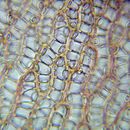Comments
provided by eFloras
Sporophytes are common in Sphagnum subnitens. The ecology of this species is unclear because of past taxonomic confusion with S. subfulvum. However, the two clearly differ in gametophyte and spore morphology (K. I. Flatberg 1985; Cao T. and D. H. Vitt 1986). The metallic sheen and strongly pointed stem leaves will distinguish this species from the somewhat similar S. capillifolium. See also discussion under 83. S. subfulvum.
- license
- cc-by-nc-sa-3.0
- copyright
- Missouri Botanical Garden, 4344 Shaw Boulevard, St. Louis, MO, 63110 USA
Comments
provided by eFloras
This species is similar to Sphagnum junghuhnianum, but it differs in having clearly widened borders near the leaf base, and by having multi-divided hyaline cells of stem leaves without fibrils and pores.
- license
- cc-by-nc-sa-3.0
- copyright
- Missouri Botanical Garden, 4344 Shaw Boulevard, St. Louis, MO, 63110 USA
Description
provided by eFloras
Plants moderate-sized, relatively robust, smaller in exposed sites, elongated in shaded sites, soft, capitulum ± large; pale green, green, yellowish, yellow-brown, brown, pinkish, purplish; with strong metallic sheen when dry. Stems brown or purplish; superficial cortical cells aporose. Stem leaves triangular to triangular-lingulate, 1.2-1.7 mm, apex acute to sometimes shortly cuspidate due to involute margins near apex, border narrow at base (less than 0.25 width); hyaline cells mostly efibrillose and aporose, 0-1(-2)-septate. Branches long and tapering, unranked. Branch fascicles with 2 spreading and 1-2 pendent branches. Branch leaves 1.3-2.7 mm, ovate to ovate-lanceolate, 1.3-2.7 mm, concave, straight, apex involute; hyaline cells on convex surface with 2-6 large, narrowly elliptic ringed pores along the commissures, but usually absent from marginal regions of leaf, concave surface aporose or with 1-4 large round pores per cell especially near base. Sexual condition monoicous. Spores 22-32 µm, finely to irregularly coarsely-papillose on proximal surface, irregularly coarsely papillose on distal surface; proximal laesura less than 0.5 spore radius.
- license
- cc-by-nc-sa-3.0
- copyright
- Missouri Botanical Garden, 4344 Shaw Boulevard, St. Louis, MO, 63110 USA
Description
provided by eFloras
Plants soft, whitish to grayish green, tinged with reddish brown, shiny when dry, in loose tufts. Stem cortex in 3–4 layers, hyaline cells without fibrils and pores or occasional with a single pore; central cylinder pale green or pale reddish purple. Stem leaves 1.3–1.5 mm × 0.7–0.9 mm, oblong isosceles-triangular, broadly acute, abruptly narrowed to a short, concave-cuspidate point, slightly dentate or lacerate at the apex; borders narrow above, clearly widened near the leaf base; upper hyaline cells rhomboidal, often divided more than once, sometimes divided several times, without fibrils and pores, or rarely with the traces of fibrils. Branches in fascicles of 3–4, with 2 spreading. Branch leaves 1.6–1.8 mm × 0.5–0.6 mm, variable in size, usually ovate-lanceolate, gradually narrowed to a blunt acumen, dentate across the apex; hyaline cells fibrillose, with small pores at the upper ends or lower ends in the upper half, gradually becoming large, rounded pores in the lower half on the ventral surface, with large, half-elliptic pores at the opposite ends along commissural rows on the dorsal surface; green cells in cross section narrowly triangular or trapezoidal, exposed on the ventral surface, enclosed by hyaline cells on the dorsal surface. Dioicous; antheridial branches reddish purple. Perigonial leaves large, ovate, borders wide, hyaline cells without fibrils and pores. Spores yellow, papillose, 25–31 µm in diameter.
- license
- cc-by-nc-sa-3.0
- copyright
- Missouri Botanical Garden, 4344 Shaw Boulevard, St. Louis, MO, 63110 USA
Distribution
provided by eFloras
Distribution: China, Himalayas, Russia (Siberia), Europe, North and South America, and North Africa.
- license
- cc-by-nc-sa-3.0
- copyright
- Missouri Botanical Garden, 4344 Shaw Boulevard, St. Louis, MO, 63110 USA
Habitat
provided by eFloras
Habitat: on wet ground and grasslands in high mountain forests.
- license
- cc-by-nc-sa-3.0
- copyright
- Missouri Botanical Garden, 4344 Shaw Boulevard, St. Louis, MO, 63110 USA
Synonym
provided by eFloras
Sphagnum acutifolium Schrad. var. plumosum Mild., Bryol. Siles. 382. 1869.
Sphagnum plumulosum Röll, Flora 69: 89. 1886, nom. inval. (as Formenreihe).
- license
- cc-by-nc-sa-3.0
- copyright
- Missouri Botanical Garden, 4344 Shaw Boulevard, St. Louis, MO, 63110 USA
Sphagnum subnitens
provided by wikipedia EN
- license
- cc-by-sa-3.0
- copyright
- Wikipedia authors and editors
Sphagnum subnitens: Brief Summary
provided by wikipedia EN
Sphagnum subnitens is a species of moss belonging to the family Sphagnaceae.
It has almost cosmopolitan distribution.
- license
- cc-by-sa-3.0
- copyright
- Wikipedia authors and editors

